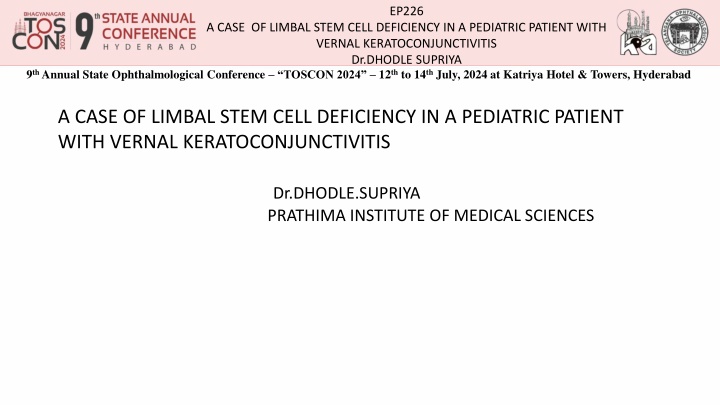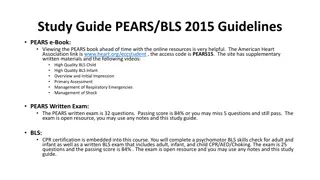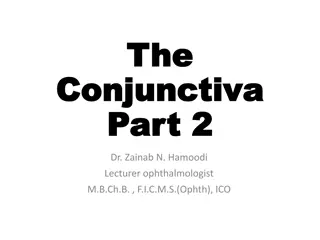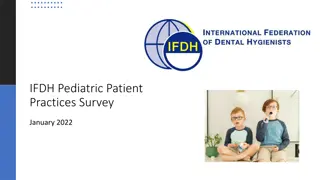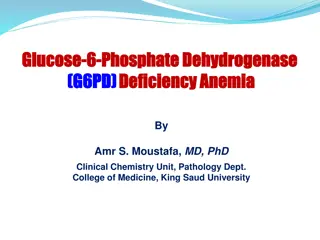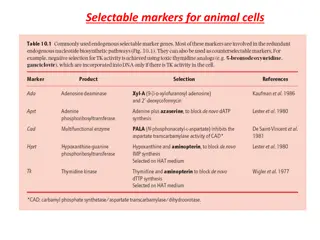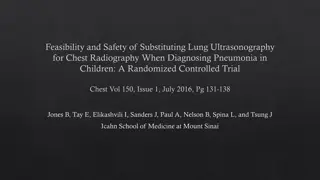Case Study: Limbal Stem Cell Deficiency in Pediatric Patient with Vernal Keratoconjunctivitis
Limbal stem cell deficiency (LSCD) is a rare condition characterized by inadequate corneal rejuvenation and conjunctivalization of the cornea. In this case study, a 14-year-old male with Vernal Keratoconjunctivitis presented with itching, eye rubbing, and corneal epithelial scarring resembling a whorl-like pattern. LSCD was confirmed, highlighting the need for early diagnosis and management to prevent vision complications.
Download Presentation

Please find below an Image/Link to download the presentation.
The content on the website is provided AS IS for your information and personal use only. It may not be sold, licensed, or shared on other websites without obtaining consent from the author.If you encounter any issues during the download, it is possible that the publisher has removed the file from their server.
You are allowed to download the files provided on this website for personal or commercial use, subject to the condition that they are used lawfully. All files are the property of their respective owners.
The content on the website is provided AS IS for your information and personal use only. It may not be sold, licensed, or shared on other websites without obtaining consent from the author.
E N D
Presentation Transcript
EP226 A CASE OF LIMBAL STEM CELL DEFICIENCY IN A PEDIATRIC PATIENT WITH VERNAL KERATOCONJUNCTIVITIS Dr.DHODLE SUPRIYA 9thAnnual State Ophthalmological Conference TOSCON 2024 12thto 14thJuly, 2024 at Katriya Hotel & Towers, Hyderabad A CASE OF LIMBAL STEM CELL DEFICIENCY IN A PEDIATRIC PATIENT WITH VERNAL KERATOCONJUNCTIVITIS Dr.DHODLE.SUPRIYA PRATHIMA INSTITUTE OF MEDICAL SCIENCES
EP226 A CASE OF LIMBAL STEM CELL DEFICIENCY IN A PEDIATRIC PATIENT WITH VERNAL KERATOCONJUNCTIVITIS Dr.DHODLE SUPRIYA 9th Annual State Ophthalmological Conference TOSCON 2024 12th to 14th July, 2024 at Katriya Hotel & Towers, Hyderabad INTRODUCTION LSCD is defined as a decrease or total lack of limbal stem cells due to a wide variety of causes. Loss of these cells results in inadequate corneal rejuvenation and conjunctivalization of the cornea. LSCD is rarely inherited, though it can be associated with aniridia, multiple endocrine deficiency, and other uncommon genetic disorders. Acquired cases of LSCD are more common, and ocular surface burns account for the vast majority of unilateral cases. Chemical burns, immune-mediated conditions (Steven's Johnson Syndrome or mucous membrane pemphigoid) and allergic ocular conditions account for the majority of bilateralcases. Allergic conditions such as VKC and atopic keratoconjunctivitis account for 30% of bilateral cases. -It is thought that eye rubbing leads to physical damage of the limbus, as well as release of inflammatory cytokines from papillae. - Most commonly seen in young males
EP226 A CASE OF LIMBAL STEM CELL DEFICIENCY IN A PEDIATRIC PATIENT WITH VERNAL KERATOCONJUNCTIVITIS Dr.DHODLE SUPRIYA 9th Annual State Ophthalmological Conference TOSCON 2024 12th to 14th July, 2024 at Katriya Hotel & Towers, Hyderabad MATERIALS AND METHODS A 14 year old male patient presented to the ophthalmology OPD complaining of bilateral ocular itching and daily eye rubbing for the past 2 years.History of Vernal Keratoconjunctivitis and Isometric refractive amblyopia with BCVA of 6/12 in RE and 6/12 in LE . On Slitlamp examination BE Palpebral Papillae present ,cornea - Epithelial scarring+whorl like pattern NaFL staining superiorly. Fundus examination OU -Within normal limits.
EP226 A CASE OF LIMBAL STEM CELL DEFICIENCY IN A PEDIATRIC PATIENT WITH VERNAL KERATOCONJUNCTIVITIS Dr.DHODLE SUPRIYA 9th Annual State Ophthalmological Conference TOSCON 2024 12th to 14th July, 2024 at Katriya Hotel & Towers, Hyderabad DISCUSSION The diagnosis was made based on the pathognomonic corneal epithelial staining, which follows a unique curvy/whorl-like pattern. Corneal ulcers were ruled out due to the absence of any infiltrate. Peripheral ulcerative keratitis was ruled out due to the absence of any known auto-immune disease. Patients with LSCD are often symptomatic for redness, tearing,pain, photophobia, and reduced vision. Impression cytology is the gold standard for diagnosis, but diagnosis can be made based on clinical signs and symptoms alone. In vivo confocal microscopy and anterior segment OCT have also proved to be useful non-invasive diagnostic tools. LSCD is progressive in nature, and can result in irregular astigmatism, recurrent erosions and ulcerations, cornealneovascularization, and ultimately corneal scarring. Opacification in the visual axis may lead to functional blindness.
EP226 A CASE OF LIMBAL STEM CELL DEFICIENCY IN A PEDIATRIC PATIENT WITH VERNAL KERATOCONJUNCTIVITIS Dr.DHODLE SUPRIYA 9th Annual State Ophthalmological Conference TOSCON 2024 12th to 14th July, 2024 at Katriya Hotel & Towers, Hyderabad TREATMENT AND MANAGEMENT In cases of LSCD due to immune-mediated diseases, such as VKC, ocular surface inflammation must be controlled. Topical medications such as ketotifen and olopatadine decrease the inflammation and severity of the papillae, decreasing mechanical rubbing and consequentially the progression of the corneal disease. Preservative free artificial tears Topical cyclosporine 0.05% BID OU alone. He is currently asymptomatic and no disease progression has been noted. Allergy related causes of LSCD are managed with topical treatment alone. In more severe cases of LSCD with visually significant scarring,surgical intervention is often required.
EP226 A CASE OF LIMBAL STEM CELL DEFICIENCY IN A PEDIATRIC PATIENT WITH VERNAL KERATOCONJUNCTIVITIS Dr.DHODLE SUPRIYA 9th Annual State Ophthalmological Conference TOSCON 2024 12th to 14th July, 2024 at Katriya Hotel & Towers, Hyderabad CONCLUSION LSCD can be caused by several etiologies including atopic ocular conditions,such as VKC,especially in pediatric patients. Careful slitlamp examination of the cornea with NaFL staining should be performed in all patients with allergy related conditions.Ophthalmologists should aware of this condition as early treatment with topical medications can prevent visually devastating outcomes and the need for surgical intervention.
